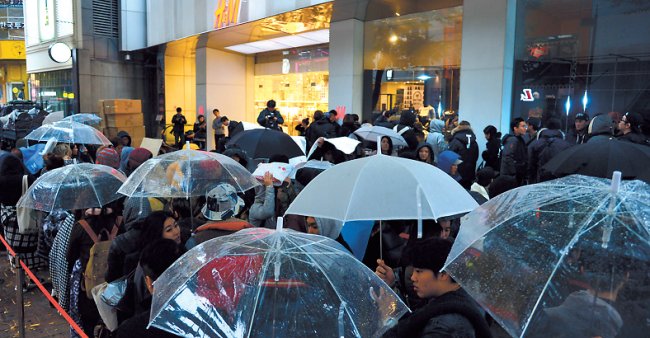[Design Forum] Fast fashion meets designer names, changes consumer trends
By Korea HeraldPublished : Nov. 19, 2014 - 21:19
This is the fifth in a weekly series that examines the expanding role of design in the run-up to the Herald Design Forum 2014 on Nov. 26. ― Ed.
Over 300 people from their 20s to their 60s camped out in the rain in front of an H&M store in Myeong-dong, downtown Seoul, in the early morning of Nov. 6.
Some were office workers who took a day off to stay up all night in the queue.
With tents and sleeping bags on the streets, they were there to get a piece of “Al Wang,” (“Wang” means king in Korean) their nickname for iconic designer Alexander Wang.
Queueing for war
On that day, H&M stores worldwide began sales of a limited-edition collection designed by Wang, the creative director of Balenciaga who runs his own labels and is currently one of the hottest designers in fashion. Famous for his unique cutouts and slick silhouettes in high-end textiles, Wang has been praised for his tailoring skills.
Over 300 people from their 20s to their 60s camped out in the rain in front of an H&M store in Myeong-dong, downtown Seoul, in the early morning of Nov. 6.
Some were office workers who took a day off to stay up all night in the queue.
With tents and sleeping bags on the streets, they were there to get a piece of “Al Wang,” (“Wang” means king in Korean) their nickname for iconic designer Alexander Wang.
Queueing for war
On that day, H&M stores worldwide began sales of a limited-edition collection designed by Wang, the creative director of Balenciaga who runs his own labels and is currently one of the hottest designers in fashion. Famous for his unique cutouts and slick silhouettes in high-end textiles, Wang has been praised for his tailoring skills.

Fans started to line up two days ahead of the launch at the clothing store, creating an unusual scene that bore resemblance to night club queues in Hongdae or Itaewon.
Due to an H&M policy, the queues went on inside the store to get into the Alexander Wang section.
A bell rang, as if to mark the start of a war, for a 10-minute shopping time given to 30 people at a time. Each person was only allowed to buy up to three items as part of an H&M collaboration marketing strategy.
Some accuse H&M of engineering the queueing for image purposes and of excessive “limited-edition” marketing. They say the strategy is to cajole consumers into wrongfully thinking that this is their last chance by flashing the label “limited edition” and to arouse some kind of marveling curiosity by making them line up.
Once again, the fancy designer collaboration marketing worked.

Most of the menswear was sold out just an hour after the H&M stores opened in Apgujeong and Myeong-dong’s Noon Square. By 3 p.m., the entire Alexander Wang collection was sold out. Groups of people carrying large, black paper bags with the “Alexander Wang x H&M” logo could be seen on the nearby streets and subway stations as they traded “war” stories.
Some purchased the clothes for their own collection, but others attempted to sell them off at almost double the price on the Internet. Previously, even the shopping bags that were given out to consumers for free during a similar H&M collaboration with Isabelle Marant were sold online.
In a nutshell, fashion brands’ “designer” marketing is resulting in aggressive consumption patterns.
Electronics, foods join designer collaboration
H&M was the trailblazer of collaboration in the fashion industry.
Having started as a womenswear company in Sweden in 1948, H&M turned itself into a SPA (specialty store retailer of private label apparel) brand in the late 1990s, handling its own production and distribution quickly to reduce costs.
The leader of fast fashion, however, sought to renew its image through designer collaborations in efforts to avoid disparaging views against fast fashion such as “cheap” clothing that is worn only for a brief time.
Starting with Chanel’s Karl Lagerfeld in 2004, H&M launched collections with top designers such as Stella McCartney, Roberto Cavalli, Rei Kawakubo, Comme des Garcons, Matthew Williams, Jimmy Choo, Sonia Rykiel, Versace, Marni, Margiela and Isabelle Marant for the past 10 years, pioneering a new brand marketing area ― fashion collaboration.
H&M’s collaborations have inspired not only other fashion brands but also beauty, electronics, food and automobile industries.
Coca Cola has been running package design collaborations with fashion designers since 2008, starting with Patricia Field who became widely known for her costume designs in popular TV series “Sex and the City.” Coca Cola went on to work with Roberto Cavalli (2008), Moschino (2009), Salvatore Ferragamo (2010), Karl Lagerfeld (2011), Jean Paul Gautier (2012) and Marc Jacobs (2013).
Cosmetics brand Lancome launched a limited edition in collaboration with Lanvin’s creative director Alber Elbaz in 2011. German dessert brand Schneeball rolled out a package design collaboration with Paul Frank as a Valentine’s Day special edition early this year.
Collaborations with designers are more than just changing the product packaging. As limited editions with a touch of culture and art, they become valuable possessions and build on brand recognition.
Such strategic partnerships with designers across all industries are changing not just the consumer culture but also the paradigm of product manufacturing.
(amigo@heraldcorp.com)
-
Articles by Korea Herald











![[Today’s K-pop] BTS pop-up event to come to Seoul](http://res.heraldm.com/phpwas/restmb_idxmake.php?idx=644&simg=/content/image/2024/04/17/20240417050734_0.jpg&u=)





![[KH Explains] Hyundai's full hybrid edge to pay off amid slow transition to pure EVs](http://res.heraldm.com/phpwas/restmb_idxmake.php?idx=652&simg=/content/image/2024/04/18/20240418050645_0.jpg&u=20240418181020)

![[Today’s K-pop] Zico drops snippet of collaboration with Jennie](http://res.heraldm.com/phpwas/restmb_idxmake.php?idx=642&simg=/content/image/2024/04/18/20240418050702_0.jpg&u=)